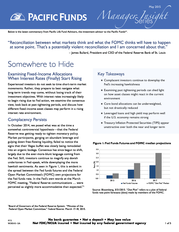Description
loans or bonds
january 2015
Chart 6: Bank loans had similar returns to high yield in 2014
while exhibiting low volatility - a pattern we believe will continue in 2015
7
6
2014 total return (%)
Barclays U.S. High Yield
CS Leveraged Loan Index
5
profile, provides the potential to participate in upside surprises via
spread compression, and thus, price appreciation, while current in-
come cushions downside risks relative to equities. For investors
that are rebalancing after another strong equity year, high yield
offers a compelling risk/reward profile.
Bank loans provide the ability diversify traditional fixed income
risk, reduce portfolio duration, and increase portfolio yields. Also,
4
given bank loans limited exposure to energy, we believe they will
3
2
1
0
-1
Jan-14
High yield bonds, given their current valuations and historic return
Mar-14
May-14
Jul-14
Federal Reserve
Sep-14
Nov-14
Source: Barclays, Credit Suisse, as of December 31, 2014
In 2014, credit risk was a clear loser to duration risk.
As a result, Loans or bonds: What’s the role in the portfolio? high yield bonds and bank loans have a more compelling relative continue to provide a low volatility return profile relative to other spread based assets. For investors rebalancing fixed income portfolios after a strong year for duration based assets, bank loans may be a perfect complement. Pacific Asset Management January 2015 value starting point than at any point in the past three years. So which asset class is more compelling? In our opinion, that depends on what an investor hopes to accomplish in the portfolio.
Outside of having a similar yield profile, each asset class may respond dif- ferently to various markets, giving them multiple roles in portfolio allocation. ABOUT PACIFIC ASSET MANAGEMENT Founded in 2007, Pacific Asset Management specializes in credit oriented fixed income strategies. Pacific Asset Management is a division of Pacific Life Fund Advisors LLC, an SEC registered investment adviser and a wholly owned subsidiary of Pacific Life Insurance Company (Pacific Life). As of December 31, 2014 Pacific Asset Management managed approximately $4.8bn.
Assets managed by Pacific Asset Management includes assets managed at Pacific Life by the investment professionals of Pacific Asset Management. IMPORTANT NOTES AND DISCLOSURES Bank loan, corporate securities, and high yield bonds involve risk of default on interest and principal payments or price changes due to changes in credit quality of the borrower, among other risks. Pacific Asset Management is an investment advisor; it provides investment advisory services to institutional clients and does not sell securities. Pacific Select Distributors, LLC.
is the distributor for Pacific Life’s retail products. Pacific Asset Management and Pacific Select Distributors, LLC. are each a wholly owned subsidiary of Pacific Life. This information is presented for informational purposes only.
This is not to be construed as an offer to buy or sell any financial instruments and should not be relied upon as the sole investment making decision. All material is compiled from sources believed to be reliable, but accuracy cannot be guaranteed. The opinions expressed herein are based on current market conditions, are subject to change without notice.
Investors should consider the investment objectives, risks, charges and expenses carefully before investing. Please read the applicable prospectus or other offering documents carefully before investing. For this and more complete information about the available investment vehicles, investors should contact their financial advisor, consultant or visit www.pacificlife.com or www.pam.pacificlife.com. FOR MORE INFORMATION Pacific Asset Management • 700 Newport Center Drive • Newport Beach, CA 92660 • www.pam.pacificlife.com 4 .
As a result, Loans or bonds: What’s the role in the portfolio? high yield bonds and bank loans have a more compelling relative continue to provide a low volatility return profile relative to other spread based assets. For investors rebalancing fixed income portfolios after a strong year for duration based assets, bank loans may be a perfect complement. Pacific Asset Management January 2015 value starting point than at any point in the past three years. So which asset class is more compelling? In our opinion, that depends on what an investor hopes to accomplish in the portfolio.
Outside of having a similar yield profile, each asset class may respond dif- ferently to various markets, giving them multiple roles in portfolio allocation. ABOUT PACIFIC ASSET MANAGEMENT Founded in 2007, Pacific Asset Management specializes in credit oriented fixed income strategies. Pacific Asset Management is a division of Pacific Life Fund Advisors LLC, an SEC registered investment adviser and a wholly owned subsidiary of Pacific Life Insurance Company (Pacific Life). As of December 31, 2014 Pacific Asset Management managed approximately $4.8bn.
Assets managed by Pacific Asset Management includes assets managed at Pacific Life by the investment professionals of Pacific Asset Management. IMPORTANT NOTES AND DISCLOSURES Bank loan, corporate securities, and high yield bonds involve risk of default on interest and principal payments or price changes due to changes in credit quality of the borrower, among other risks. Pacific Asset Management is an investment advisor; it provides investment advisory services to institutional clients and does not sell securities. Pacific Select Distributors, LLC.
is the distributor for Pacific Life’s retail products. Pacific Asset Management and Pacific Select Distributors, LLC. are each a wholly owned subsidiary of Pacific Life. This information is presented for informational purposes only.
This is not to be construed as an offer to buy or sell any financial instruments and should not be relied upon as the sole investment making decision. All material is compiled from sources believed to be reliable, but accuracy cannot be guaranteed. The opinions expressed herein are based on current market conditions, are subject to change without notice.
Investors should consider the investment objectives, risks, charges and expenses carefully before investing. Please read the applicable prospectus or other offering documents carefully before investing. For this and more complete information about the available investment vehicles, investors should contact their financial advisor, consultant or visit www.pacificlife.com or www.pam.pacificlife.com. FOR MORE INFORMATION Pacific Asset Management • 700 Newport Center Drive • Newport Beach, CA 92660 • www.pam.pacificlife.com 4 .













